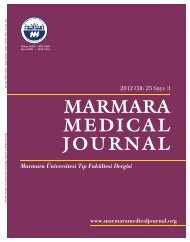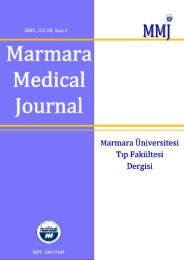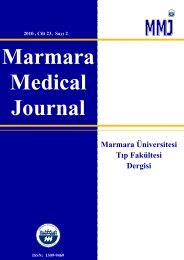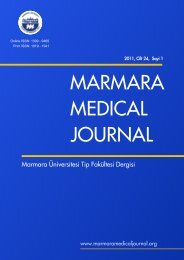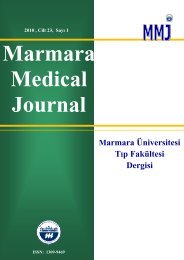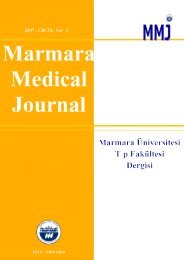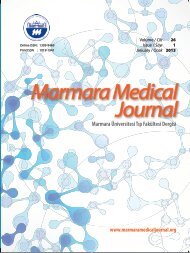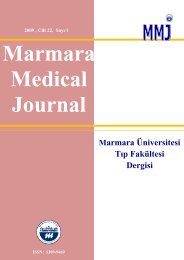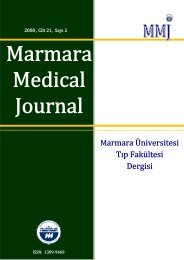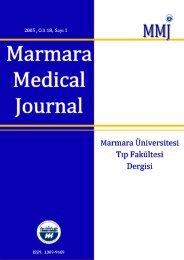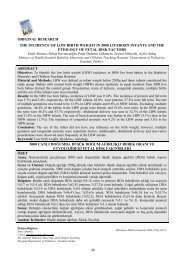Tam Metin PDF (3983 KB) - Marmara Medical Journal
Tam Metin PDF (3983 KB) - Marmara Medical Journal
Tam Metin PDF (3983 KB) - Marmara Medical Journal
Create successful ePaper yourself
Turn your PDF publications into a flip-book with our unique Google optimized e-Paper software.
<strong>Marmara</strong> <strong>Medical</strong> <strong>Journal</strong> 2006;19(2);86-89<br />
Ahmet Sert, et al<br />
Two new kabuki cases of kabuki make-up syndrome<br />
In addition to the distinct facial features, he also<br />
had high arched palate, persistent fetal finger<br />
pads, arachnodactyly, bilateral simian line and<br />
umblical hernia. Cardiac examination revealed no<br />
significant murmurs. The other system findings<br />
were normal. Laboratory examinations were<br />
within normal limits. Chest radiography showed<br />
no cardiac enlargement. Echocardiography<br />
demonstrated mesocardia with no other associated<br />
cardiac anomalies. He was diagnosed as Kabuki<br />
make up syndrome due to clinical findings.<br />
Figure 2: Male patient showing facial dysmorphic features<br />
suggestive for Kabuki make-up syndrome.<br />
DISCUSSION<br />
Kabuki make-up syndrome was established with<br />
clinical findings in both patients. Currently, there<br />
is no consensus on the diagnostic criteria for<br />
Kabuki syndrome and there is no clinically<br />
available genetic test to confirm the diagnosis. In<br />
1988, Niikawa et al. reported on the clinical<br />
findings in 62 patients diagnosed with Kabuki<br />
syndrome. Based on the findings in these patients,<br />
five cardinal manifestations were defined. These<br />
included a ‘peculiar face’ (eversion of the lower<br />
lateral eyelid, arched eyebrows with the lateral<br />
one-third dispersed or sparse, depressed nasal tip,<br />
and prominent ears) in 100% of their patients,<br />
skeletal anomalies (deformed spinal column with<br />
or without sagittal cleft vertebrae, and<br />
brachydactyly V) in 92% of their patients,<br />
dermatoglyphic abnormalities (fingertip pads,<br />
absence of digital triradius c and/or d, and<br />
increased digital ulnar loop and hypothenar loop<br />
patterns) in 93% of their patients, mild to<br />
moderate mental retardation in 92% of their<br />
patients, and postnatal growth deficiency in 83%<br />
of their patients. There have also been a number<br />
of less frequent findings reported in Kabuki<br />
syndrome, including visceral abnormalities,<br />
premature breast development in females, and<br />
susceptibility to frequent infections 3,7 . Tutar et al.<br />
reported the first non-Japanese Asian case with<br />
Kabuki make up syndrome who had premature<br />
thelarche from Turkey 8 . In our study, the female<br />
patient had premature telarche and serious<br />
infection was established in the boy. The<br />
dysmorphic features of our patients are in<br />
accordance with detailed clinical findings<br />
observed in Kabuki patients.<br />
Although diagnosis relies on dysmorphic features,<br />
neurological symptoms are the most invalidating<br />
manifestations in the Kabuki syndrome clinical<br />
spectrum, often presenting as the first complaint;<br />
nevertheless, Kabuki syndrome is still a rare<br />
diagnoses at neurology clinics 4 . Neurological and<br />
endocrinological anomalies that are reported to<br />
include neonatal hypotonia, feeding problems,<br />
seizures, West syndrome, microcephaly, brain<br />
atrophy, growth hormone deficiency, precocious<br />
puberty, hypoglycemia, delayed sexual<br />
development, and diabetes insipidus. Other<br />
neurological abnormalities observed are<br />
subatrophy of the optic nerves, subarachnoid cyst,<br />
cerebellar and brainstem atrophy, and epilepsy<br />
2,9,10 . In accordance with the literature, the female<br />
patient presented with developmental delay and<br />
seizures. On the other hand she also had<br />
microcephaly. Schrander-Stumpel et al. reported<br />
29 Caucasian patients and reviewed 60 Japanese<br />
and 29 non-Japanese patients, noting that non-<br />
Japanese patients with this syndrome had more<br />
marked neurological symptoms. In over 80% of<br />
non-Japanese patients, neurological symptoms<br />
were a major clinical problem 11 . Precocious<br />
puberty is an occasional finding in the syndrome.<br />
Early breast development was noted in 7 of 31<br />
female Japanese patients. Endocrine studies in 5<br />
cases demonstrated markedly elevated plasma<br />
follicle-stimulating hormone and moderately high<br />
prolactin levels 3 . Bereket et al. reported that the<br />
diagnosis of Kabuki syndrome should be<br />
considered in patients with hypoglycemia or<br />
premature thelarche when associated with<br />
developmental delay and a peculiar facies 10 . The<br />
girl patient did not have precocious puberty but<br />
had markedly elevated plasma follicle-stimulating<br />
hormone levels which is consistent with literature<br />
data.<br />
88




